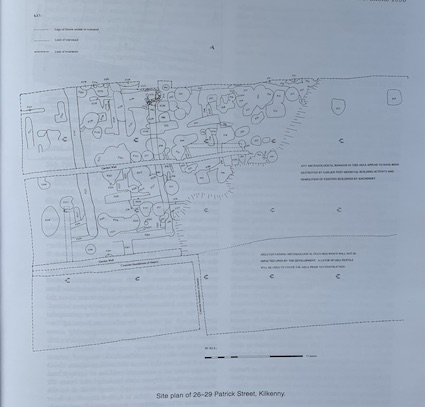County: Kilkenny Site name: KILKENNY: 26–29 Patrick Street
Sites and Monuments Record No.: N/A Licence number: 98E0092
Author: Judith Carroll, Pine Forest Art Centre
Site type: Pit
Period/Dating: Multi-period
ITM: E 650616m, N 655676m
Latitude, Longitude (decimal degrees): 52.649923, -7.251968
The site consists of the back gardens of 26–29 Patrick Street, Kilkenny, along with the house currently standing at No. 26. The development (by Jeto Properties Ltd) consists of a hotel and office complex. All of the areas of the site to be affected by the development have been excavated. On the south-east of the site archaeological layers were exposed but will not be damaged and have been covered by a layer of geo-textile.
The excavation on the site was a condition of planning as a result of the trial-testing in February 1998.
Patrick Street is first recorded on William Petty's 17th-century map of Kilkenny and was a main thoroughfare of the medieval town in the 17th century. It was flanked by tall stone houses. On the west side (where the site lies) these houses have marked garden plots. Plots corresponding with the stone boundary walls upstanding on the site appear on John Roque's 18th-century map of Kilkenny. It had originally been suggested by archaeologists carrying out trial-trenching at the site that these walls corresponded with the boundaries of medieval burgage plots. However, upon excavation many pits and trenches of probable 12th–16th-century date did not respect these boundaries and ran directly under the foundations of the surviving walls.
The excavation took place over an area c. 50m x 35m from 9 March to 27 April 1998. Earlier building activity and the demolition of existing structures had already heavily damaged the eastern end of the site, so that in part no archaeological level survived. The excavation produced considerable evidence of both medieval and post-medieval activity. Analysis of the pottery and other finds from the site has yet to take place, so remarks on the dating of features on the site are provisional.
The site is characterised by a dense concentration of pits. Most of the features appear to be medieval in date, probably 12th–16th century, although there were also some post-medieval pits. A substantial linear palisade trench divides the area of pits and other features from a less archaeologically rich area. This palisade trench (F160) continues in the area of excavation to the north (No. 358, Excavations 1998). It appears to be contemporary with the pits in this area, as it produced medieval pottery (probably late 12th–14th century in date) similar to that from the pits. The palisade trench may be a boundary between the original medieval burgage plots and more open agricultural or common land; none of the pits on the site cut it. Most of the pits to the west of the trench appear to be post-medieval in date, and one in particular produced a large and varied amount of 17th-century pottery and glassware.
The earliest feature on the site seems to be F82, a ditch that runs north-south across the site. It is cut by a series of pits, some of which are medieval in date. At the northern end of the ditch was a stone structure that seems to relate directly to it. F82 may be an earlier enclosure pre-dating F160 and most of the pits, although its precise purpose and function are as yet unclear.
It had been thought that the stone garden walls upstanding on the site before excavation may have related to the boundaries of medieval burgage plots. However, this has not been borne out by excavation. Many medieval features run under the walls, and the only features that appear to respect them are post-medieval in date. Many of the houses on Patrick Street were built or refurbished during the Georgian period, and these walls probably relate to this phase in the development of Patrick Street.
It is intended that detailed post-excavation analysis of the material from the excavation will take place in conjunction with work on the material from the adjacent site at Patrick Street/Pudding Lane, Kilkenny (No. 358 Excavations 1998).

Pine Forest Road, Glencullen, Co. Dublin